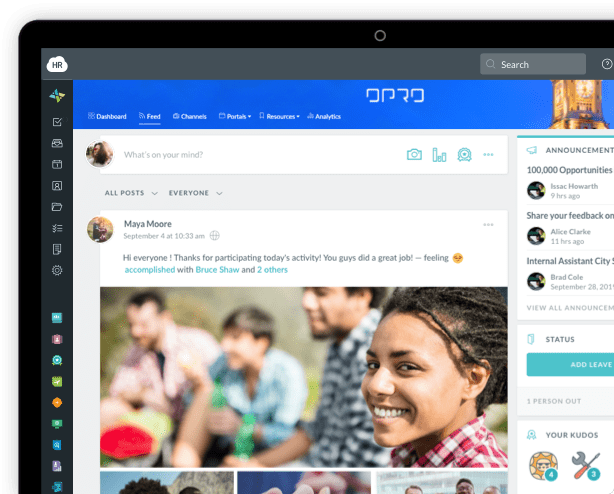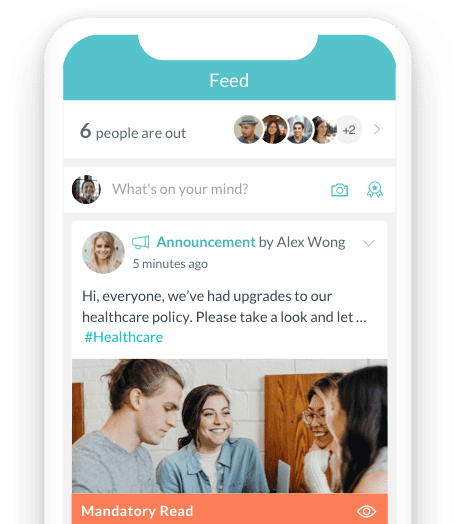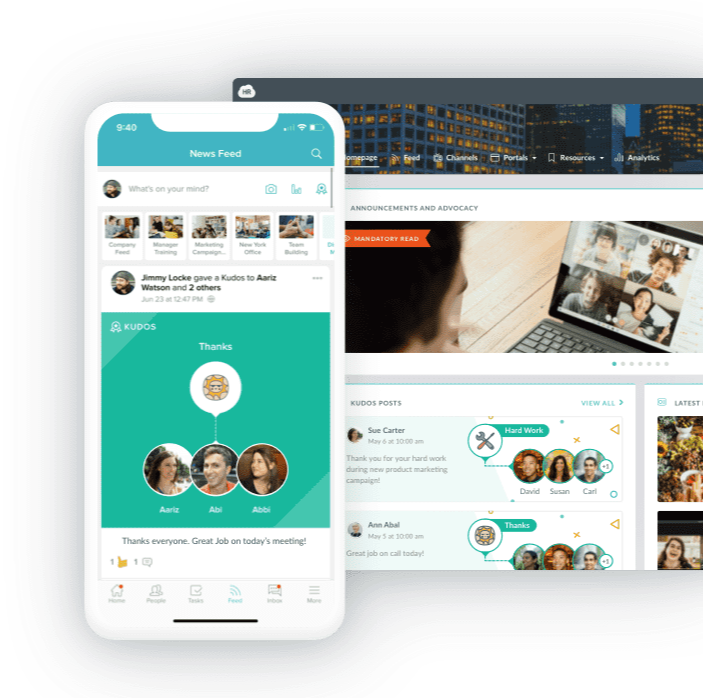Why Employee Engagement Is Important for an Innovative Work Culture
-1.png)


 Cut onboarding time
by 60%—here's the
Ultimate Checklist
that helped do it.
Cut onboarding time
by 60%—here's the
Ultimate Checklist
that helped do it.

Employee engagement is a complex topic. Difficult to promote and even harder to measure, it’s all too often oversimplified – or worse overlooked completely. In fact, findings from a recent Gallup report show a mere 21% of global employees are engaged at work.
Is Your Company's Culture
Working Against You?
culture with our short quiz.
The organizations employing that 21% have a major competitive advantage. They’re driving business growth through increased innovation whilst their competitors are battling with the adverse effects of employee disengagement.
But what is it about an engaged workforce that promotes innovation, and what practices can you implement to encourage one? To answer this, we first need to understand exactly what the term ‘employee engagement’ means.
What Is Employee Engagement?
Though often taken to mean the same thing, there is a considerable difference between job satisfaction and employee engagement. Job satisfaction implies a person gets a sense of fulfillment from their work. They may be satisfied with their role, pay and working hours, but that is where their personal investment ends.
Engagement, on the other hand, covers every aspect of employment. Not just the work of the individual but also the people they work with and the organization they work for.
A highly engaged employee feels a positive connection on all fronts. They:
-
Enjoy and take pride in their own responsibilities
-
Care about the success of their teammates
-
Hold a strong affiliation with their employer
-
Are motivated, supportive and have a genuine interest in the continued growth of the company they work for
On the other end of the scale sits the disengaged employee. These people show little interest in their employment, essentially working for a paycheck and nothing more.
At best a disengaged employee will show up, fulfill their duties, and go home again. At worst, they’ll spread negativity around the workplace, cause disruption among teams and limit a company’s growth potential.
There is of course a sliding scale between the highly engaged and the disengaged. Those who fall somewhere in between may do no harm to an organization, but neither will they contribute to its success.
If you can create a work environment in which all employees are highly engaged though, you’ll find you also create a culture of innovation – and that is what lies at the heart of every successful business.

How Does Employee Engagement Encourage Innovation?
Before we explore how and why employee engagement contributes to innovation, we should first stress that we’re not limiting innovation to R&D or technical advancement. We’re referring to any new approach that improves some aspect of business performance.
In this context, innovation may mean a new marketing strategy that sees greater ROI or improvements to your customer-service model. It may relate to new efficiencies in your supply chain or streamlined workflows that boost productivity.
Essentially, to innovate is to bring new ideas to the table with the aim of driving better outcomes than those seen through current practices. When you have a highly engaged workforce, those ideas are more forthcoming.
This is because engaged employees are:
More Productive
With high levels of engagement come high levels of productivity. That’s not just an empty claim – it's something 81% of business leaders strongly agree with. But how does this fact relate to innovation?
Well, a productive worker gets more done in a shorter time frame. Their to-do lists are ticked off at a much quicker rate than those of unproductive workers, leaving more time for reflection. This ‘thinking time’ encourages critical analysis, where an employee may identify working inefficiencies and put forward innovative ideas to fix them.
Increased productivity also gives employees more time to bounce ideas off of each other, fueling creativity and constructive debate.

Team Players
Engaged employees aren’t out for themselves. They’re invested in collective achievement, and as such make strong team players. This helps drive innovation in a couple of ways.
First, it creates a supportive team environment built on trust and mutual respect. This makes it easier for team members to voice their ideas without fear of rejection. It also makes them more inclined to take calculated risks, knowing they have a supportive team to fall back on.
Second, team players welcome diversity in collaboration. They know that a collective is greater than the sum of its parts, and that the best results are achieved when people with different backgrounds, skills and experience work together. By happy coincidence, this is also how the most innovative ideas come into being.
Happier and Healthier
Employee wellbeing plays a big role in engagement. Organizations that focus on the former – through initiatives like flexible work schedules and enforced lunch breaks – see an increase in the latter, whilst at the same time encouraging a happier and healthier workforce.
Healthier staff are more alert, energized and focused, meaning they’re far more likely to have those eureka moments. It also goes without saying that a happy employee is more inclined to go the extra mile, potentially breaking new ground in the process.
Social Intranet Software that Encourages Employee Communication

In It for the Long Term
An engaged employee feels a strong sense of loyalty to their employer and is unlikely to seek out new job opportunities. They are in it for the long term, so you hold on to your most creative talent.
Commitment and longevity contribute to innovation because those responsible for new ideas are there to oversee and guide their implementation. If a disengaged employee brought something new to the table (which is unlikely to happen), you have no guarantee they’ll stick around to see it through.
With more engaged employees, you’ll also see lower staff turnover, which means fewer resources spent on recruitment and training. That’s time and money you can invest in innovation.
Invested in Company Growth
Last but not least, highly engaged employees care about the future of the organization they work for. This is because:
- Their employer treats them well
- There exists a shared set of values
- They feel valued as an integral part of the business
It’s also because, as we’ve established, they’re in it for the long haul. Most will see themselves progressing up the managerial chain so it’s in their best interest for the company to do well.
Given that innovation is a key driver of business growth, those invested in that growth will be key drivers of innovation.

Unlock a Bonus Strategy to Improve Team Efficiency And Productivity
How to Improve Employee Engagement for Innovation
Employee engagement should be seen as a long-term strategy rather than a set of isolated activities. That strategy must be based on the needs of each individual business, but there are core practices every organization should incorporate:
Design an Effective Recruitment Process
Employee engagement starts with recruitment. HR teams must attract the right talent and focus on an onboarding process that firmly cements that talent as a vital part of the organization.
Have an Open Communication Policy
Open communication helps to establish a united work environment – one in which a shared vision exists and all voices are heard and respected. It drives engagement by helping employees connect their role with wider business goals.
Encourage Growth and Development
Organizations should provide training opportunities that enable continued growth. This shows an employee that their potential is recognized and that career progression exists within the company. The act of learning new skills is also a driver of engagement in itself.
Recognize and Reward Achievement
To keep employees engaged, their hard work and commitment should always be acknowledged and their achievements celebrated. Organizations that focus on employee recognition not only retain top talent but also motivate them to achieve even more.

HR mistakes impact your entire organization. Learn how to avoid the 12 most common mistakes with our free ebook.
Download nowFocus on Employee Wellbeing
Wellbeing initiatives are critical to employee engagement. They alleviate stress and contribute to a healthy work–life balance, as well as being a welcome gesture of appreciation. All of this goes a long way to promoting a deeper connection between an organization and its workforce.
HR to Drive Employee Engagement and Innovation
HR has a vital role to play in an employee engagement strategy. From initial recruitment and onboarding to training and development, HR departments must ensure engagement initiatives are designed, implemented and overseen to full effect.
They must also work collaboratively with top-level management in the rollout of new approaches that maintain engagement, and subsequently promote an innovative work culture.
Final Thoughts
Employee engagement is more than job satisfaction and shouldn't be considered a 'nice-to-have'. Organizations that want to thrive, innovate and grow need to implement policies and practices that lead to fully engaged employees. They will reap savings in time, money and resources, and have happier, healthier employees who are in it for the long term.
Want to Improve Your
Company Culture
is right for you.
Author Bio:
Jen Morris is a freelance writer with extensive experience across multiple sectors, including recruitment, eCommerce, marketing and events.
With a background in journalism, Jen uses effective writing techniques to educate, engage and entertain readers on her client's behalf, driving brand exposure with cleverly crafted content.
Keep Reading
45 Boss Day Messages That Actually Mean Something (2026 Guide)
When is Boss Day 2026? Mark your calendar for October 16, 2026 — the annual opportunity
Birthday Wishes for Coworkers: 50+ Messages That Build Workplace Connection
A coworker's birthday isn't just another calendar date—it's a meaningful opportunity to
Embracing Diversity: Recognizing Different Cultures in the Workplace
Workplaces today reflect the incredible diversity of the world around us. People bring
Like What You Hear?
We'd love to chat with you more about how HR Cloud® can support your business's HR needs. Book Your Free Demo

Build a Culture of Recognition. Boost Engagement. Guaranteed.
Workmates empowers employees to stay informed, connected, and appreciated—whether they’re on the front line, in the office, or remote. Recognition drives 12x higher engagement.Trusted by industry leaders in every sector




Cut Onboarding Costs by 60%.
Take the confusion and follow-ups out of onboarding with automated workflows, digital forms, and structured portals—so new hires ramp faster 3X quicker.Trusted by industry leaders in every sector





